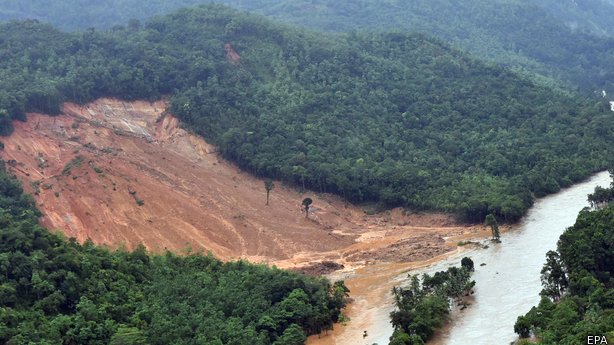land slides

Forest-based Landslide Risk Management in Sri Lanka
CHALLENGE
Sri Lanka is highly vulnerable to natural hazards, including floods, droughts, and landslides, which are exacerbated by population growth, urbanization, uncontrolled land-use change, and deforestation. The World Bank is implementing several programs to improve the government’s resilience to such natural risks. Notably, the Climate Resilience Improvement Project (CRIP) aims to reduce the immediate physical risks, such as by stabilizing hillsides with concrete, nets and drainage pipes, and to improve the understanding of disaster risks so that future investments are effectively targeted. Under CRIP-II (in preparation), basin investment plans will be developed and published on an online platform and co-financed by the Bank and other donors. There is also an ongoing technical assistance (TA) program that is supporting the National Building Research Organization (NBRO), the main organization responsible for landslide risk management in the country, on assessing landslide hazard and exposure and analyzing mitigation measures.
Even though it is recognized that deforestation and uncontrolled land-use change contribute significantly to landslide risks, forest-based solutions are generally not applied in Sri Lanka because of the government’s limited experience and expertise in such solutions. Therefore, to ensure the best results of the programs being invested in Sri Lanka, PROFOR’s activity seeks to build the NBRO’s capacity to understand and apply forest-based solutions.
APPROACH
This activity will support the Government of Sri Lanka in piloting and potentially scaling-up the use of forest-based solutions for landslide risk management, through the following tasks and outputs:
- Development of a capacity building program for NBRO to understand and apply forest-based solutions to mitigate landslide risk in selected regions of Sri Lanka. This will include a training (and the production of relevant training materials); a study tour; and a South-South knowledge exchange.
- Assessment of legal, institutional and regulatory frameworks for the application of forest-based solutions for landslide risk management in Sri Lanka. This assessment will result in the identification of opportunities and possible bottlenecks.
- Development of a comprehensive forest-based landslide risk management plan for 1-2 selected areas.
- Preparation of a guidance document on the potential use of forest-based solutions for landslide risk management in developing countries.
The above activities will leverage the lessons learned from and connect to the ongoing World Bank projects: CRIP, CRIPII (in preparation), and the TA on landslide risk management in order to contribute to the overall disaster risk management investment planning in Sri Lanka. The activity will also be linked to the PROFOR-funded Global Knowledge Management Program on Forest and Disaster Risk Management.
RESULTS
In selecting appropriate landslide stabilization measures, three dominant factors need to be considered: cost, constructability, and safety. As landslides are very localized phenomena, site specific mitigation measures are needed for slope stabilization such as geotechnical structural measures that include soil reinforcement, soil nailing, rock bolting, surface protection, slope modification, retaining walls, gabion walls, breast walls, soil removal works, steel pile works, etc. The structural measures require sophisticated designs and the costs are very high. The NBSs are an attractive option as they are low cost and can be applied to large areas.
Almost all landslide mitigation measures in Sri Lanka have used engineered solutions, and NSBs generally have not been used in Sri Lanka until recently. The main reason for this is that the counterpart has limited experience and expertise in such solutions and therefore has relied on engineered solutions. Therefore, the NBRO capacity building program provided them with the knowledge about what plants are suitable for NBSs and how these can be applied together with engineering solutions or as stand-alone practices. NBRO now have used the hybrid solutions to improve the performance of the engineering solution in the road failures along the Kandy Mahiyangana road. Applying NBSs on top of an engineering solution will stabilize the solution more and will provide additional safety and sustainability of the structure. The NBRO engineers now work with landscape architects, botanists and other non-engineering experts to design the hybrid and integrated solutions.
The NSBs are more suitable as a mitigation measures for shallow landslides and the hybrid solutions, where the NBSs are used in combination with structural and technological measures, are more appropriate to mitigate the deep-seated landslides. The hybrid solutions will bring down the cost significantly when compared to the structural measures that are used alone. It is useful to recognize Nature Based interventions as a cost-effective option and get more confidence in application of the same as a standalone practice or as a practice with other engineering measures. It is essential to establish a separate unit at NBRO for undertaking research and demonstration activities on nature-based solutions that will enhance the knowledge base significantly.
The manual on “Nature Based Solutions for mitigation of Landslide risk” is serving as a guidance manual on application of nature based as well as hybrid solutions. to the manual is used by practitioners and engineers in NBRO, relevant local authorities, other practitioners to design, implement and monitor nature-based solutions for landslide and erosion risk reduction under a range of physical conditions. The nature based and especially hybrid solutions presented in this guide are chosen specifically to Sri Lanka’s need for landslide risk reduction. In addition, it is expected that the vegetation cover may make the appearance of slopes as natural as possible, and help in creating not only safer but also more visually acceptable and ecologically sustainable slopes.
For stories and updates on related activities, follow us on twitter and facebook , or subscribe to our mailing list for regular updates.
Last Updated : 06-15-2024








